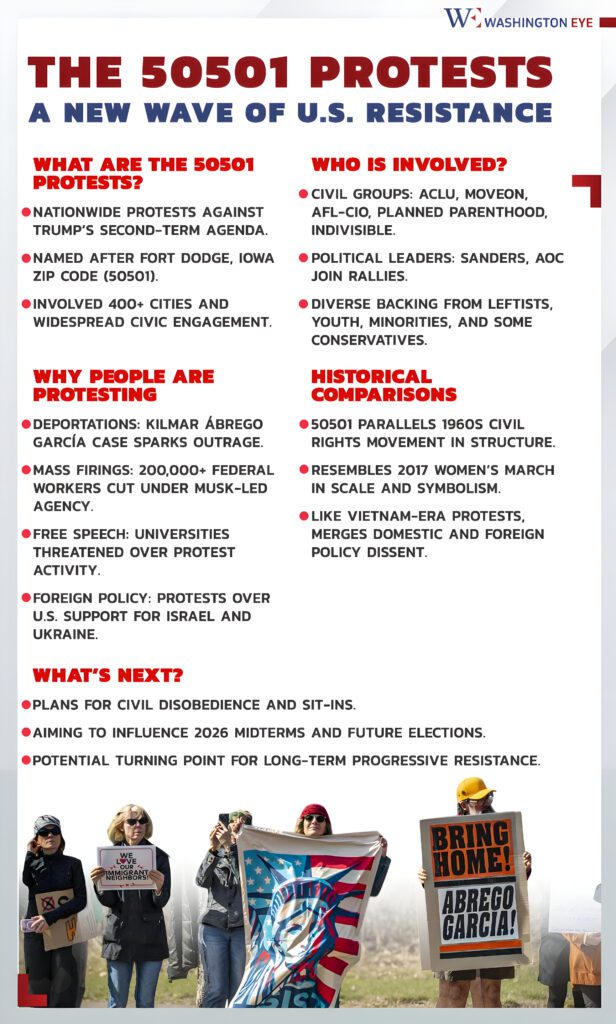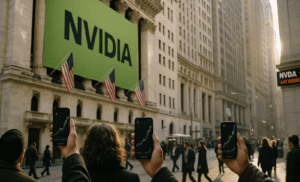A wave of defiance is sweeping across the United States as thousands of demonstrators unite in growing resistance to President Donald Trump’s second-term agenda. Frustrated by policies they view as authoritarian, discriminatory, and destructive to democratic institutions, Americans from all walks of life have taken to the streets in cities large and small.
The most recent display of civic unrest—known as the “50501” protests—follows closely on the heels of the “Hands Off” movement, marking a resurgence of organized, large-scale activism not seen since the early days of Trump’s first presidency. These protests reflect more than partisan outrage; they are a deep, broad-based response to what many perceive as a systematic dismantling of civil liberties, public services, and constitutional norms.
Roots of the Uprising: From ‘Hands Off’ to ‘50501’
The “50501” protests were not spontaneous eruptions but rather the result of deliberate organizing across a broad alliance of civil society groups. They emerged as the successor to the “Hands Off” movement, which first mobilized on April 5, 2025. That earlier wave involved more than 1,200 actions nationwide and was led by over 150 organizations, including the ACLU, MoveOn, Planned Parenthood, labor unions like the AFL-CIO, and numerous grassroots coalitions. According to Reuters, the “Hands Off” movement was conceived in direct opposition to Trump’s sweeping domestic agenda—a set of initiatives that opponents argue threaten basic democratic principles and civil protections.
Building on this foundation, the April 19 “50501” demonstrations adopted a more explicit anti-authoritarian tone. The name itself refers to the postal code for Fort Dodge, Iowa—symbolizing the geographical heart of the country and, according to organizers, the need for resistance to be as expansive and representative as the nation itself. Rallies took place in more than 400 cities and towns, and many featured teach-ins, voter registration drives, and appearances by Democratic lawmakers and progressive political figures.
The Policy Flashpoints Igniting Resistance
A major driver behind the protests has been the administration’s intensified immigration crackdown. The wrongful deportation of Kilmar Ábrego García, a Salvadoran man with legal residency in the U.S., became a symbol of what critics describe as a broken and discriminatory enforcement system. His case has sparked widespread anger and was cited by many protest organizers as a catalyst for national action.
Another key issue has been the gutting of the federal workforce. Under the newly formed Department of Government Efficiency, led controversially by Elon Musk, over 200,000 federal employees have been dismissed. Critics argue that these layoffs disproportionately affect agencies providing social services and regulatory oversight, thereby weakening the state’s ability to serve the public. The move has raised questions not only about economic impacts, but also about the centralization of executive power.
Higher education and freedom of expression have also become flashpoints. The administration has threatened to revoke the tax-exempt status of universities that it deems to be “promoting antisemitism or political bias”—a thinly veiled reference to campuses that host pro-Palestinian protests or diversity programs. Trump specifically targeted Harvard and Columbia University, accusing them of fostering “hate and division”—language that critics view as chilling and authoritarian. However, these threats have deeply alarmed educators and civil liberties advocates, who see them as attempts to politicize academic freedom.
On the foreign policy front, demonstrators expressed outrage at U.S. support for Israel’s military operations in Gaza and continued military aid to Ukraine. Organizers accuse the administration of fueling global conflicts and enabling human rights violations. This critique is not only coming from the political left; some libertarian and non-interventionist conservatives have also joined calls for rethinking America’s role abroad.
Political and Cultural Reverberations
The protests have had a ripple effect beyond the streets. They’ve reignited political activism among younger Americans and historically marginalized groups, many of whom feel that democratic institutions are under siege. The size and frequency of the demonstrations suggest that opposition to Trump is not merely partisan—it is structural, touching on issues of governance, transparency, and human rights.
In addition to civic groups, a number of high-profile politicians have lent their voices to the movement. Senator Bernie Sanders called the protests a “rebuke of fascism in our time”, while Representative Alexandria Ocasio-Cortez attended a New York City rally, declaring that “resistance is not just a slogan—it’s a necessity”. The symbolic impact of these protests, amplified by social media and livestream coverage, has energized segments of the electorate ahead of the 2026 midterms and prompted renewed fundraising among progressive candidates.
There’s also a cultural dimension to this mobilization. The protests have become spaces for artistic expression and coalition-building, resembling elements of Occupy Wall Street and the Women’s March. Music, performance art, and community teach-ins have helped frame the movement as one of collective creativity in the face of state repression.
A Final Note: What’s Next?
The road ahead is uncertain, but organizers suggest the protests are only the beginning. Groups like Indivisible and the Sunrise Movement have hinted at sustained civil disobedience campaigns, including sit-ins at federal buildings and pressure campaigns targeting congressional Republicans. With the presidential election looming in 2028, these actions may become a litmus test for the political viability of progressive resistance.
While the administration has so far dismissed the protests as “radical theatrics”, political analysts note that ignoring such a large and organized civic uprising could prove short-sighted. If the White House continues its aggressive policy trajectory, it risks both domestic unrest and legal challenges. The 50501 protests are thus more than a temporary flash of dissent—they could mark the early formation of a long-term opposition movement capable of influencing both national discourse and electoral politics.

















